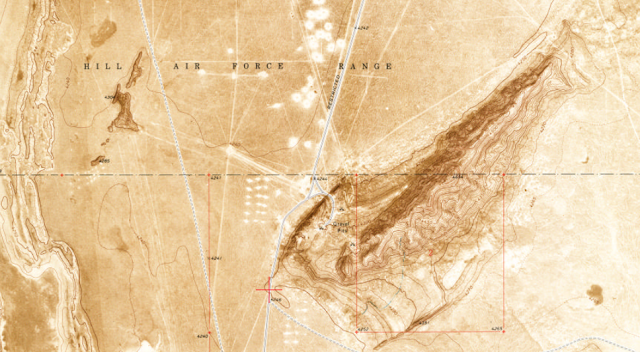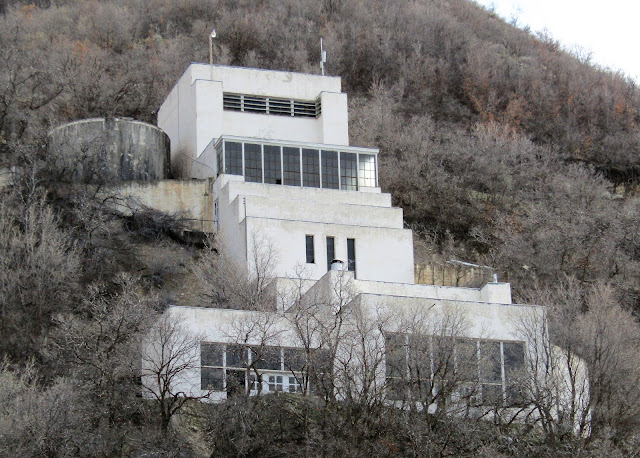The Flying Rocket Apes of Hurricane Mesa
by Peter
This is a story of breaking the soundbarrier, saving lives, and shooting crash test dummies and apes off of the edge of a cliff.
The story begins in the years after World War II. Although aircraft ejection systems had been tested as early as 1910 and ejection seats were tested and sometimes used during the war by Germany, Sweden, and other countries; most pilots still exited stricken planes by 'bailing out,' jumping clear under their own power.
Ejection seats started to be more regularly used in the late 1940s and into the 1950s, powered by solid propellant charges. At the same time, jets were getting faster and the propellant charges were often not able to throw the pilot clear of the plane quickly enough. In fact, in this period only 20% of ejecting pilots were unscathed. The other 80% were injured or killed. The propellant charges could not be strengthened, because the sudden acceleration could damage the pilot's spine. Instead, companies working for the Air Force began experimenting with rocket-propelled ejection seats. But how do you test a rocket-propelled ejection seat meant for supersonic planes? You cannot reasonably crash that many planes to test the ejection systems.
Instead, the Air Force contracted with the Coleman Engineering Company to build the Supersonic Military Air Research Track. Essentially, they built a 2.25 mile long continuously-welded track to carry a rocket-propelled sled that could reach speeds of 1,050 miles per hour (Mach 1.3). The track was located on Hurricane Mesa, northeast of the town of LaVerkin, and ran right up to the edge of the mesa's cliff.
Just before reaching the edge, the ejection seat being tested would fire, flinging the seat, usually occupied by a test dummy named Hurricane Sam, off the cliff to float 1,500 feet down toward the Virgin River. The track and related facilities were constructed from 1954-1955 and the first test took place on July 8, 1955. Over the next six years, the Air Force and Coleman undertook around 334 tests to standardize ejection seats. At one point, they replaced Hurricane Sam with live apes to test the ejection seats on living beings. Coleman set a land speed record by getting their sled up to 1,800 miles per hour. They also tested missiles and allowed other companies to test their systems.
After 1961, the Air Force reduced their involvement, but the track continued to be used by private aeronautics companies. It is currently owned by Goodrich, but appears to be used only sporadically.
This is a story of breaking the soundbarrier, saving lives, and shooting crash test dummies and apes off of the edge of a cliff.
The story begins in the years after World War II. Although aircraft ejection systems had been tested as early as 1910 and ejection seats were tested and sometimes used during the war by Germany, Sweden, and other countries; most pilots still exited stricken planes by 'bailing out,' jumping clear under their own power.
Ejection seats started to be more regularly used in the late 1940s and into the 1950s, powered by solid propellant charges. At the same time, jets were getting faster and the propellant charges were often not able to throw the pilot clear of the plane quickly enough. In fact, in this period only 20% of ejecting pilots were unscathed. The other 80% were injured or killed. The propellant charges could not be strengthened, because the sudden acceleration could damage the pilot's spine. Instead, companies working for the Air Force began experimenting with rocket-propelled ejection seats. But how do you test a rocket-propelled ejection seat meant for supersonic planes? You cannot reasonably crash that many planes to test the ejection systems.
Instead, the Air Force contracted with the Coleman Engineering Company to build the Supersonic Military Air Research Track. Essentially, they built a 2.25 mile long continuously-welded track to carry a rocket-propelled sled that could reach speeds of 1,050 miles per hour (Mach 1.3). The track was located on Hurricane Mesa, northeast of the town of LaVerkin, and ran right up to the edge of the mesa's cliff.
Just before reaching the edge, the ejection seat being tested would fire, flinging the seat, usually occupied by a test dummy named Hurricane Sam, off the cliff to float 1,500 feet down toward the Virgin River. The track and related facilities were constructed from 1954-1955 and the first test took place on July 8, 1955. Over the next six years, the Air Force and Coleman undertook around 334 tests to standardize ejection seats. At one point, they replaced Hurricane Sam with live apes to test the ejection seats on living beings. Coleman set a land speed record by getting their sled up to 1,800 miles per hour. They also tested missiles and allowed other companies to test their systems.
After 1961, the Air Force reduced their involvement, but the track continued to be used by private aeronautics companies. It is currently owned by Goodrich, but appears to be used only sporadically.


Comments
Post a Comment